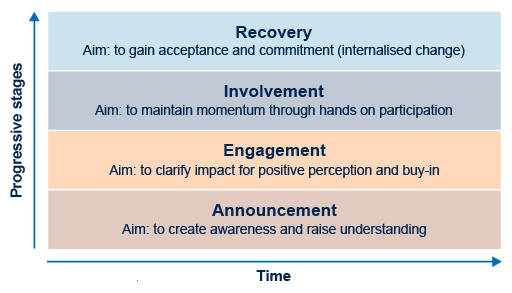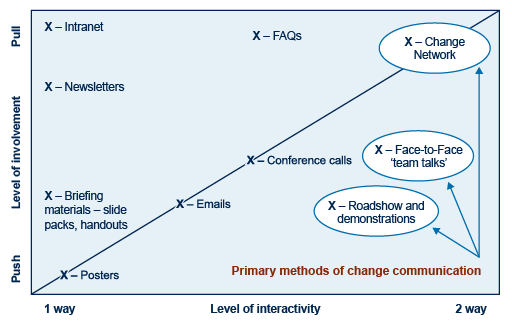4.1 The importance of a communications plan
The objectives of the communications plan are to:
- build understanding and support of the change initiative and facilitate successful implementation
- build trust, commitment and ownership
- change behaviours of colleagues to contribute towards the future direction and success of the implementation and business change
- build manager and leader capability around communications by providing tools and resources to drive ownership of dialogue with all stakeholder groups
- engage all stakeholders where opportunities exist for dialogue
- monitor and measure feedback.
It is essential that leaders and project teams initiating the change remember that their knowledge and acceptance of the change is much further ahead than colleagues who have just heard of it. It is important that leaders and project team members remember to pace themselves with the learning and understanding of others.
The communication approach needs to change as people shift from receiving information to making sense of what they have heard and identifying the implications for themselves, their work and relationship with others. These initial shifts require the communications to change from a telling and selling communication style to one of question and answer, enabling exploration and involvement in what it means for individuals. Through involvement, people gain commitment and understand the situation themselves, resulting in changes in behaviour.
Gaining people’s commitment to proposed changes is a progressive process. Communication is the most significant key to achieving engagement (buy-in) and commitment from those impacted. Figure 8 below illustrates the communication stages through which individuals typically progress as they transition towards becoming fully engaged and committed to the initiatives being undertaken.
The impact of missing out stages in the communication progress can be as follows:
- No engagement can result in negative perception and resistance to the change – people need to understand how the change will impact them, i.e. What does it mean for me?
- No involvement might mean a loss of support – individuals need to feel that they are part of the change effort rather than feeling like it is being done to them.
- No recovery can result in regression – if the change is not embedded to become business as usual (BAU), it very easily starts to regress to ‘how it used to be’.
Table 3 shows some of the common methods of communication used by change agents.
Often a change communications plan (the headings of which could be as indicated in the table) will make use of many channels.
| Element | Example |
|---|---|
| Date | Date of message |
| Change stage | Announcement, engagement, etc. |
| Key message and objective | The key points you want/need to get across to the audience |
| Audience | The group that is being targeted |
| Channel | Method, such as changing network email |
| Owner | Who is the message going from, and who is actually writing it? |
| Evaluation | How will you assess success? Survey, feedback, focus groups? |
There many communication changes, so it is important to consider what you are trying to communicate and to whom to choose the most appropriate. Figure 9 provides some of the main ones you might consider for internal communication. It suggests the primary methods of change communication are roadshows and demonstrations (the ‘Go see’); team talks which may be delivered face-to-face or virtually either as remote-only or hybrid events; and the development of a change network. We will discuss change networks in the next section.
Whichever channel is used, a few guiding principles should be followed:
- be visible and accessible
- take an open and honest approach
- focus on two-way communications
- schedule timely, planned communication and engagement activity
- have clear, consistent and credible messaging
- use tailored communications targeted to specific audiences
- use efficient and straightforward communications that are ‘fit for purpose’
- face-to-face (in person or virtually) communication should be the primary channel, with written and other forms as secondary channels
- gather regular feedback and evaluate.
It is important that the appropriate style of communication is used to ensure that the messaging is clear, concise, correct, concrete, coherent, complete and courteous, which are often referred to as the 7 Cs of communication, as explored in the next section.


